The irresistible allure of science fiction that feels not just plausible, but scientifically grounded, captivates our imagination. It allows us to explore the vast unknowns of space, technology, and consciousness through a lens of reality. Unlike pure fantasy, science-based sci-fi grounds its speculative elements in known physics, biology, chemistry, or computer science. This reliance on scientific principles, even when pushing their boundaries, is what sets these films apart and sparks genuine curiosity about the real universe and technology, making complex concepts accessible and exciting.
This article dives into some top science fiction films celebrated for their scientific accuracy or insightful use of scientific principles, analyzing how they integrate complex ideas into compelling narratives. For those interested in the scientific principles themselves, resources like NASA’s science pages offer great starting points.

Gravity, Relativity, and Cosmic Journeys
This category focuses on films that deeply engage with fundamental physics like relativity, gravity, and the structure of spacetime, often involving grand journeys across the cosmos.
Interstellar (Gravitational Waves, Wormholes, Time Dilation)
Interstellar is renowned for its commitment to depicting complex physics. Key concepts include General Relativity, the intense gravitational effects around black holes like ‘Gargantua,’ the theoretical possibility of wormholes as shortcuts through spacetime, and relativistic time dilation, where time passes slower near massive objects or at high speeds.
Physicist Kip Thorne served as the film’s scientific advisor. His crucial role guided the visual effects team in creating arguably the most accurate depiction of a black hole seen in cinema up to that point, based on actual physics equations.
While the visualization of gravitational effects and the black hole closely follows current understanding, elements like stable, traversable wormholes and accessing higher dimensions venture into scientifically informed speculation necessary for the plot. These complex physics concepts are not merely special effects; they are fundamental drivers of the story, dictating character actions, emotional stakes, and the very possibility of the mission. The film expertly weaves these scientific ideas into a narrative about survival and humanity’s future.
Surviving the Elements and Ingenuity
These movies explore scenarios where survival hinges on applying scientific knowledge and engineering principles in extreme, often alien, environments.
The Martian (Mars Survival, Botany, Orbital Mechanics)
The Martian presents a series of realistic scientific challenges faced by stranded astronaut Mark Watney on Mars. He must solve critical problems:
- Producing Water: Combining leftover hydrogen fuel with oxygen.
- Growing Food: Using Martian soil, his own waste as fertilizer, and harvested potatoes inside the habitat.
- Communication: Modifying existing equipment to contact Earth.
- Power Generation: Utilizing and augmenting solar panels.
The film’s depiction of Mars, its thin atmosphere, dust storms, and potential habitats aligns closely with current NASA plans for future Mars missions and existing space technology. The scientific rigor stems from Andy Weir’s extensive research for the novel, which detailed each step of Watney’s scientific problem-solving process. The film successfully translates this into a compelling visual narrative that celebrates human ingenuity and scientific application under pressure.

Communication, Cognition, and First Contact
Films in this section tackle the scientific and philosophical challenges of understanding and communicating with potential extraterrestrial intelligence.
Contact (SETI, Radio Astronomy, Wormhole Travel Theory)
Contact delves into the real-world science behind the Search for Extraterrestrial Intelligence (SETI) and radio astronomy. It accurately portrays the use of vast array telescopes like the Very Large Array (VLA) to scan the cosmos for non-random radio signals and the process of analyzing vast amounts of data.
The film explores the scientific plausibility of receiving a structured signal – one containing prime numbers – as evidence of intelligent design. It also highlights the immense scientific challenge of decoding a truly alien language or message. While the method of physical travel depicted involves theoretical physics concepts (influenced by Carl Sagan and Kip Thorne), the core of the story is grounded in the science of listening to the universe.
Arrival (Linguistics, Sapir-Whorf Hypothesis, Time Perception)
Arrival centers on the fascinating field of theoretical linguistics. The monumental task faced by Dr. Louise Banks is deciphering a fundamentally alien language structure, which is non-linear and symbolic, unlike any human language.
A central plot device is the exploration of the Sapir-Whorf hypothesis, also known as linguistic relativity. This theory suggests that the structure of a language can influence or even determine the speaker’s perception of the world and cognition. Arrival speculatively applies this, proposing that learning the alien language could alter human perception of time. The film’s unique portrayal of non-linear time perception is scientifically informed speculation on the potential profound impact of language on the human brain.
AI, Consciousness, and Simulation
This section covers films that explore the scientific and philosophical frontiers of artificial intelligence, sentience, and the nature of reality itself.
Ex Machina (Turing Test, AI Ethics, Consciousness)
Ex Machina offers a claustrophobic yet profound look at advanced Artificial Intelligence. While the film moves beyond a simple demonstration of the Turing Test, the test’s core idea – evaluating a machine’s ability to exhibit intelligent behavior equivalent to, or indistinguishable from, that of a human – underlies the premise of evaluating Ava.
The film deeply probes the scientific and philosophical questions surrounding consciousness: what does it mean to be conscious? Can a machine truly achieve sentience or self-awareness? These themes relate directly to real-world AI development, the rapid advancements in machine learning, and the increasingly complex ethical debates surrounding the creation of powerful, potentially sentient, artificial minds.
The Matrix (Simulation Hypothesis, Neurobiology)
The Matrix popularizes the simulation hypothesis – the idea that our reality could be a sophisticated computer simulation. This concept draws on ideas from physics (like the fine-tuning of universal constants) and computation (the increasing power of simulations). Philosophers and scientists continue to debate its plausibility.
The film’s depiction of plugging minds directly into a digital world relates to real-world research in neurobiology and brain-computer interfaces (BCIs). Scientists are actively developing technology to allow direct communication between the brain and external devices, albeit currently on a much simpler level than shown. The concept also touches on the neurobiological implications of altering sensory input and how the brain constructs our perceived reality.
Near-Future Technology and Space Exploration Realism
These films forecast plausible technological advancements and attempt to depict the realities of space travel within our solar system and nearby space with greater fidelity.
2001: A Space Odyssey (Space Travel Realism, AI)
Guided by science writer and futurist Arthur C. Clarke, 2001: A Space Odyssey achieved groundbreaking realism in depicting spaceflight for its era. The film accurately portrayed the physics of movement in vacuum, spacecraft design (like the rotating station for artificial gravity), and the sheer scale and silence of space.
The portrayal of HAL 9000 remains a complex and eerily relevant depiction of advanced AI, raising questions about machine sentience, logic, and potential system failures when faced with conflicting directives. Clarke’s scientific background lent significant credibility to the film’s technical details and future predictions.
Ad Astra (Realistic Space Travel Challenges, Psychological Effects)
Ad Astra attempts to depict the scale, duration, and physical demands of travel within the solar system more realistically than many sci-fi films. While containing some dramatized elements, it shows the monotonous reality of long journeys between planets and the logistical challenges involved.
The film touches on plausible (though heightened for plot) space hazards, such as micrometeoroid impacts and the dangers inherent in navigating diverse celestial environments. Importantly, Ad Astra focuses on the often-overlooked but scientifically acknowledged factor of the psychological and emotional toll of long-duration, isolated space missions on astronauts.
The Spectrum of Scientific Accuracy
It’s important to understand that scientific accuracy in science fiction exists on a spectrum. Some films, like The Martian or Interstellar (in its physics concepts), strive for high scientific rigor, working closely with consultants and adhering to known laws as much as possible. Others, like Arrival or The Matrix, use scientific concepts (linguistics, simulation theory) more as a jumping-off point for philosophical exploration, character development, or dramatic effect.
Artistic license is often a necessity for compelling storytelling and dramatic pacing. A perfectly accurate space disaster might not be as visually engaging, or a scientific solution might be simplified for a general audience. The role of scientific consultants in filmmaking is crucial in balancing scientific integrity with narrative needs, helping filmmakers make informed choices even when they decide to bend the rules.
| Film | Primary Scientific Focus | Strives for High Accuracy? |
|---|---|---|
| Interstellar | Relativity, Black Holes, Time Dilation | Yes (physics concepts) |
| The Martian | Mars Survival, Botany, Engineering | Yes |
| Contact | SETI, Radio Astronomy | Yes (the search) |
| Arrival | Linguistics, Sapir-Whorf Hypothesis | Yes (linguistics theory) |
| Ex Machina | Artificial Intelligence, Consciousness | Yes (concepts/ethics) |
| The Matrix | Simulation Hypothesis, Neurobiology | Yes (concepts) |
| 2001: A Space O. | Space Travel Physics, AI | Yes (for its time) |
| Ad Astra | Realistic Space Travel, Space Psychology | Yes (scale/psychology) |
Conclusion
Science-based science fiction is a powerful genre that manages to entertain, educate, and inspire simultaneously. Films like Interstellar, The Martian, and Arrival demonstrate how complex scientific ideas – from relativistic time dilation and orbital mechanics to theoretical linguistics and AI consciousness – can be woven into gripping human stories.
These movies make daunting scientific concepts accessible and exciting for a broad audience. By showcasing the principles that govern our universe or the cutting edge of technological possibility, they can spark curiosity, encourage critical thinking, and potentially even inspire the next generation of scientists, engineers, and explorers to delve deeper into the real-world mysteries that science fiction loves to explore.
FAQ
Q: How accurate is the science in Interstellar?
A: The depiction of black holes and time dilation based on General Relativity is considered highly accurate due to Kip Thorne’s involvement. However, elements like stable, traversable wormholes and the interpretation of the ‘tesseract’ are scientifically informed speculation rather than proven facts.
Q: Could someone really survive on Mars like Mark Watney in The Martian?
A: The scientific principles used by Mark Watney (creating water, growing food, modifying equipment) are based on real chemistry, physics, and engineering. While the likelihood of one person solving all those problems alone is dramatized, the methods themselves are considered largely realistic based on current scientific understanding and NASA planning.
Q: What is the Sapir-Whorf hypothesis mentioned in Arrival?
A: The Sapir-Whorf hypothesis suggests that the language we speak influences how we think and perceive the world. Arrival takes this idea and explores it speculatively, proposing that learning a non-linear alien language could allow a human to perceive time non-linearly.
Q: Does The Matrix’s simulation hypothesis have a basis in real science?
A: Yes, the simulation hypothesis is a philosophical and theoretical concept debated by physicists, philosophers, and computer scientists. It’s not proven, but it’s discussed in the context of computational limits, fundamental physics, and the nature of reality.

